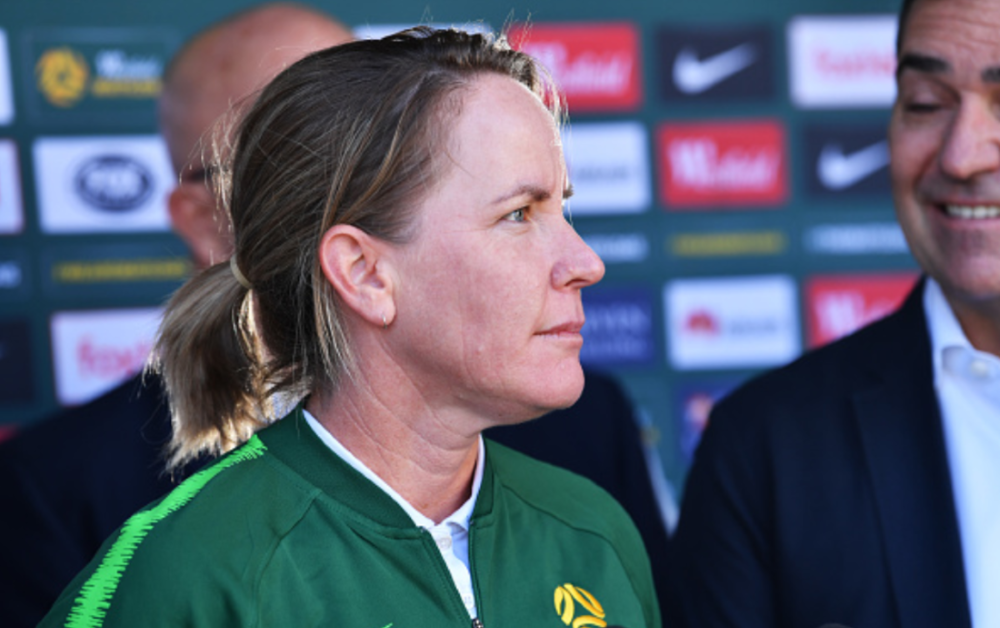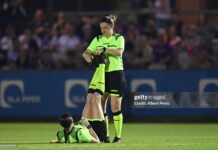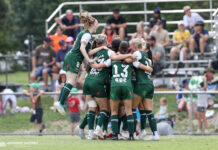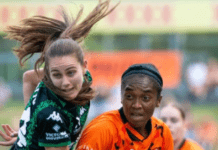
Last week, it was announced that Mel Andreatta left her role as Brisbane Roar’s W-League Head Coach. Initially it felt a bit devastating to be losing yet another top women’s coach, but this is different. Upon reflection, a glass half-full approach highlights that this is actually a very positive thing, not just for the Brisbane Strikers, but also for the women’s game.
Stay with me.
Firstly, Andreatta will work with the Strikers for a significantly longer season than the 12-14 competitive games in the W-League, a key factor to support Andreatta’s coaching aspirations. Secondly, in what era or numbers have we seen female coaches progress to the men’s game?
Brisbane Strikers
The Strikers have a goal to be the number one NPL club in Australia, and the appointment of Andreatta is a compelling addition.
When asked about her move to the Strikers, Andreatta highlighted that she was approached by the club, who saw in her someone to help them reach the next level, as reported in their media release.
“She is the perfect coach to lead this age group in their final step in our Academy and fully prepare and promote players into senior football,” Nacho Ferrer, Brisbane Strikers Technical Director said.
“The situation came up pretty suddenly and quickly in that the Strikers were looking to improve what they were doing and learned of my pending departure,” Andreatta said.
“Nacho [Ferrer, Brisbane Strikers Technical Director] has been at big clubs like Real Madrid and working with the Spanish Federation for a number of years. He’s accustomed to complex situations and developing high performing environment.
“So he just said, ‘I think I can help you learn and develop. And I think this could be another good step for you. And this is what we want to do and this is how we think you can help us. We can be flexible, we’re going to give you two assistant coaches. You pick whatever, and let’s go for it’. So it just felt right. I had to say yes. I’m excited, very excited.”
https://twitter.com/bnestrikers/status/1169778465597349888
If you rewind less than 12 months, some were wondering if Andreatta could be an outside chance to replace Alen Stajcic as Head Coach of the Matildas.
“I hadn’t begun in my Pro Licence yet. I was not really in a place where I was looking ahead in terms of my career, but after another W-League season under my belt, and after being at a World Cup, I think my eyes have opened up to all the possibilities,” Andreatta said.
“There’s massive growth and opportunities in the game and I really do aspire to be a National Team coach. Whether that’s the Matildas, I can’t say, but I definitely want to be coaching a national team or finding the right opportunity, internationally or domestically, at the highest level.
“For now, the Strikers is definitely the right fit for me. It allows me to continue with the Matildas as an assistant coach.”
Andreatta went on to explain the similarities and differences between the men’s U-18 competition compared with the W-League and international women’s football, and how this will benefit her coaching skills in the long run.
“With the under 18s especially, the game is played at a level that’s similar to or beyond W-League and international women’s football in terms of speed, so that’s a really positive thing to be coaching at that level and with so many more games. It’s going to be 20–30 plus games in the NPL season. That has an advantage over W-League as well at this point.
“There are a few reasons why I think this next step will help me progress my career but also, once Nacho was talking about the players and helping them progress into the top team and Youth National Team, I bought into that vision of development, a ‘nurture your own’ philosophy, and it was a pretty easy sell for him in the end.”
For any coach, measuring progress and understanding the success criteria is a key element to understanding if what they’re doing is working. For Andreatta, the goals are clear.
“Number one is retaining and recruiting local young men who aspire to play in the Strikers’ top team and play a certain style. Nacho has a very clear vision of what that style of football looks like, and that aligns with how I like to play the game.
“Success will include not only the numbers of players that progress through the 16s and 18s into the top team, but also into the youth boys national teams.
“Next season in the NPL will be about improving upon our finishing spot in the league from this season. The specifics of that will be something that will be discussed and developed with the players and the staff when we all come together.”
Supporting Women Coaches
So while taking a role with the Strikers is a great match for Andreatta, she’s pensive about the future for women coaches.
“I think the work that the FCA [Football Coaches Australia] are doing to better support and protect coaching rights and coaching conditions is really important,” Andreatta said.
“Females most definitely need additional support because there are so few females in football. For that to occur, I think more programs that are sustainable for supporting females, like FFA’s Female Coach Mentor Program, are critical.
“I have been put on this pathway in large part because of that program and the support that was offered to me from the FFA and the Australian Sports Commission.”
At a state-by-state level, there’s more to do to complement FFA’s program.
“I know in Queensland we’re trying to establish something similar for female coaches because we have noticed a trend. For example, in the C Licence, many coaches start the course, but there are a majority who go from that course and don’t submit their licence assessment to actually get the licence.
“There’s a pool of coaches there who have had a spark and thought ‘I need this licence,’ but then we lose them. They don’t actually get the licence, which then prevents them from coaching at a good level, at NPL. We go on a merry-go-round again, of trying to find qualified coaches.
“We’re looking closely at that right now, actually, with Kerry Hammersley, the Women’s and Girls Development Officer at Queensland Football, and Tom McDonald, the High Performance Officer, to get these coaches together and really dig deeper into what this licence does for them. Why do they need it? And how can we better work with them to provide support through our processes, with their use of time, to get them across the line, to keep them in the game, or to keep them on the coaching pathway? It’s really complex.”
So while FFA and Queensland are looking at the problem, Andreatta is conscious that it’s a complicated problem to solve.
“I don’t think there’s any one answer. I think the first step is we, as leaders, need to keep digging deeper and talking with coaches about what is needed to help them progress through the game at different levels.”
FFA’s Female Coach Mentoring program already looks to be successful, with many alumnae in key roles in Australia and overseas.
https://twitter.com/bristolcitywfc/status/1170033926368190464
“I would suggest that for the FFA and the Australian Sports Commission, success would look like how many of us—there were six on the first course—have progressed into national teams, and I think they’ve been pretty successful from the first cohort.
“I think involvement with national teams would be a good success criteria and then W-League, as well as staying in the game.”
Staying in Touch
With one eye focused domestically, the other needs to focus internationally and identify what Australia and the coaching system here need to do to stay in touch with the international game, particularly with the growth and success of women’s football in Europe.
“I read a really good article about it over the weekend. That first round [Barclay’s FAWSL] coincided with the international window for the men. The stadiums were free. It was more accessible to the women games to be played there.
“Similarly to what we’ve seen happen in the W-League, does a one-off gesture really make for a sustainable, commercial product that keeps people interested and engaged with it?
“Or do they sit down and go ‘no, this is going to be a fully fledged real product, we’re going to be in these type of stadiums week in, week out. We’re going to have coverage for every game, week in, week out [to be] really accessible to fans.’ They’ve created the free FA Player app, free sign up, watch all the games.”
Andreatta is quick to reflect that the women’s game needs to be prioritised, with a long-term strategy that’s invested in so it’s not a one-game phenomenon.
“Generally that’s the big picture and that’s the only way forward if we’re going to stay in touch anywhere near the European leagues.
“I think we have to partner with the US. Europe is going to become a powerhouse; we need to continue to strengthen our partnerships with the US and Asia, we need to be allies so that players feel that they could stay and be supported to continue to play at a higher level and develop as players themselves in good quality leagues.
“I don’t know what the future looks like for the NWSL. If it tries to expand, then what happens to us? What that would mean for us, the length of our season, and to the players that we get in our league? I would hate to think that the W-League would be diminished.
“If that had happened when we lost that golden generation of players, the Cheryl Salisbury’s, Joey Peters and Walshy [Sarah], the young ones to come—the Sam Kerrs—wouldn’t have had a league to develop in. Where would they have been?”
There’s more to be done, that we all know, but where do we start?
“I hope in the Leagues Working Group Committee there is some deep, lengthy, complex conversations about how the next three, five, ten years look for the W-League with those key stakeholders and Club owners, including the Americans and even Asia FAs towards a sustainable and successful league in the Asia-Pacific region.”
On the Future for the Matildas and the W-League
At least for the moment, Andreatta thinks the Matildas and the W-League are okay.
“I think we’re on the right track for the Olympics qualification process,” Andreatta reflected.
As for the W-League, “I just want to see an exciting, exciting league. And I would love to see all these teams really pushing even more so than last year for those final four spots. I think, from what I’ve heard, there’s going to be some very interesting signings, and it’s going to be another very competitive league this season.”
So while it’s a loss that the Roar Corp and beyond will feel greatly, let’s say congratulations and think of this in the context of it just being football without gender. Andreatta may have just landed on her feet in the best way possible.






